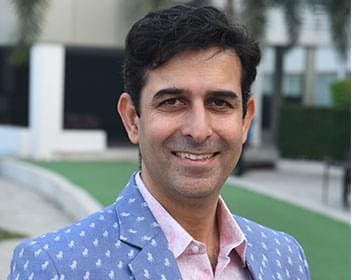Raymond Group is one of India‘s largest branded fabric and fashion retailers. The Group owns apparel brands like Raymond Ready to Wear, Park Avenue, Park Avenue Woman ColorPlus &Parx. All the brands are retailed through ‘The Raymond Shop’– One of the largest networks of over 720 retail shops spread across India and overseas, in over 35 cities, apart from Exclusive Brand Outlets as well as Large Format Stores such as Shoppers Stop, Lifestyle, Central, etc.The Raymond Shop is a premium retail store offering complete wardrobe solutions for men and has been a pioneer in organized retailing in the country starting around five decades ago.
TVC INTERVIEWED MR.MOHIT DHANJAL WHO IS THE RETAIL DIRECTOR AT RAYMOND LTD.
TVC:What has been the trend of consumption of fabrics and garments in the past 5 years?
MD:As per market and industry data:
- Total Indian apparel market in 2014 is approximately INR 2,48,700Crores (USD 41 billion) and the market is growing at 9% peryear.
- Around 20% of the market is ready-to-stitch and rest 80% is ready-to-wear market.
- Total e-tailing market in India is USD 2.3 billion as of 2014 and apparel and lifestyle [includes category like apparel, footwear, accessories (bags, belts, wallets) watches, eyewear, personal care, jewellery, etc.] account for 30% of the total e-tailing market which is USD 0.69 billion.
TVC: Do you think consumers postpone fabric and garment purchases in the years of high consumer prices and purchase more when prices have reduced?
MD:Raymond is an aspirational brand and its products are generally sold at full price. Consumers purchase our products as they aspire to wear quality products. We offer discounts in particular seasons but never reduce price asa discounting strategy. On integrated platforms, discountsare given byplatform owners and not by our company. Price is nothing but a value proposition. At X price, X value will be given, that price then gives value to consumer whether to buy or not. With right price, right quality needs to be given.
TVC:We learn that some leading mills and garment manufacturers are starting their own platform to sell their products. Do you think this trend will remain confined to top companies in the field?
MD:For companies already having Brick and Mortar stores, it makes sense for them to develop an Omni-channel strategy thereby integrating Online and offline channels into a seamless retail solution. Consumers then have a choice of ordering Online and getting products delivered to their desired location directly or from one of the brand’s neighbourhood stores.
Raymond has always had a presence in the Brick and Mortar model which provides ambience and impeccable service to itsconsumer. Conversation of sale is not easy in this competitive world and personal touch, custom tailoring and other value added services go a long way in creating a trustworthy brand with loyal customers. Raymond has 720 stores in 350+ cities. Physical presence makes a huge difference giving consumer confidence that their needs and wants are understood and taken care of by sales representatives/ company and also gives them home-like feeling. It also builds trust with the consumer where they know that the shop will not be closed overnight.
Sooner or later, companies having physical presence will start their own online e- com website. Studies in USA also show that Brick model along with Online model works quite well. Companies who do not have physical presence, for them integrated platform is the best source to reach customers. But that also needs brand awareness, so they take time to sell. It is not viable for them to create their ownwebsite and sell as they need lot of marketing to drive traffic. Many sales aggregated sites(snapdeal, flipkart, myntraetc) are working better than company direct websites but they also create that platform by aggressive marketing, persistent advertising and relentlesspromotion for driving traffic to their websites.
TVC:What is the ideal system of retailing from the point of view of manufacturers and from the angle of consumers?
MD:There are no different angles; they are 2 sides of the same coin. Manufactures have to think as per consumer, as it is a consumer centric economy and not manufacturing centric economy. We need to think how we can give wider services and product portfolio to consumers. E-tailing increases consumption, as in discounting scenario consumer tends to buy more with bundle packages offered by e-tailing. Therefore consumption is growing with the onset of Online
TVC:Do you think products like fabrics or garments or home textiles are sold on strength of their feel, drape and fibre composition whereas price and mortar model scores over the rest?
MD:Fabricsand garments mostlyget sold on look, feel, drape, colour and design/fit. Raymond is the leader in woollen fabricsin India. Fashion conscious consumers aspire to try different fibresthat areavailableglobally. We commercially launched Linen with a distinctive Raymond style, with excellent & superior quality.
Consumers don’t really care about fibre composition and its percentage. They mostly care about feel, colourand price. Fibrecomposition is nothing butatechnical quality of a fabric. Eg. Polywool % written on alabel of a garment; still they will prefer the look and its feel no matter what the percentage is. Description of fibre composition for online retailers makes a little difference as consumersimagine how it feels and try to understand the texture after reading the composition. As an industry it is our responsibility to teach consumers about different fibres; their blends and benefits. Manyfibre companies now talk about fibres as brands for retail purposes to create awareness. Eg. Cotton USA for cotton fibre, LIVA for viscose fibre, Woolmark for woollen fibre, Lycra for Spandex fibre, etc.

